Puget Sound Dungeness crab fisheries faced with summer closures south of Vashon Island due to poor abundance levels 2
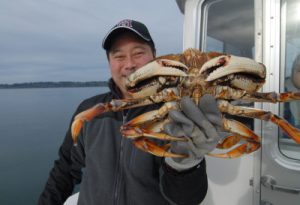
Mark Yuasa holds up a nice Dungeness crab caught in southern Puget Sound, which are off-limits this summer due to a dramatic decline in population levels.
The hey days of the Puget Sound Dungeness crab fisheries could be a thing of the past as some marine areas mainly south of Seattle will be faced with summer closures due a drastic dip in abundance.
“We haven’t been this low in Puget Sound for Dungeness crab harvest since 2012, and in general it was below average last year,” said Don Velasquez, a state Fish and Wildlife Puget Sound regional shellfish biologist.
“We did crab abundance testing in Area 11 (south-central Puget Sound) and the Puyallup Tribes did testing in Area 13 (southern Puget Sound), and the consensus is that things aren’t looking good for those areas,” Velasquez said.
Due to that poor abundance of Dungeness crab the sport fishery in south-central and southern Puget Sound will be closed this summer to all crabbing including red rock crabs.
As part of the summer crab fishing negotiations the tribal managers will also forgo a commercial season in those southern marine areas from Vashon Island southward.
Other areas that are seeing a downturn in Dungeness crab abundance are central Puget Sound (Area 10) and the southern portion of Hood Canal (Area 12) as well as the east side of Whidbey Island (Areas 8-1 and 8-2), but closures for those areas weren’t announced.
There are some factors that shellfish managers are attributing this recent decline in southern Puget Sound crab populations with two- and three-year-old male Dungeness crab populations – averaging 4.4 inches – missing or not detected, and four-year-old crabs – averaging 5.4 inches – greatly reduced. Legal-size Dungeness crab are usually five-year-old and older averaging 6 ¼ inches or more.
“We’ve had some pretty extreme surface water events in 2014 and 2015, and it is a possibility the abnormally high-water temperatures could have played a role in the downtrend,” Velasquez said. “When young of the year Dungeness crab are faced with these types of conditions they tend to die at a much higher rate.”
Other factors in decline are a distant source of brood stock for larval production and inconsistent larval advection; low dissolved oxygen levels; ocean acidification; restricted water flow south of the Tacoma Narrows; and excessive harvest.
To make matters worse extremely low density of Dungeness crab could affect successful mating.
In all inland marine catch areas, the total Dungeness crab harvested in 2017 season was 9,285,912 pounds in all fisheries compared to 10,645,000 in 2016.
In San Juan Island region north to Canadian border there was 5,096,978 pounds landed; northern Puget Sound and east side of Whidbey Island, 2,988,573 pounds; in Strait of Juan de Fuca east of Neah Bay to Admiralty Inlet, 864,103 pounds; central Puget Sound, 116,709 pounds; Hood Canal, 184,001 pounds; south-central Puget Sound, 26,086 pounds; and southern Puget Sound, 9,462 pounds.
The state harvest Puget Sound-wide (includes Hood Canal and Strait of Juan de Fuca) in 2016 for Dungeness crab was 5,295,000 pounds for sport and non-tribal fishermen, and of that the sport catch total was 2,381,000 pounds. Tribal fishermen caught 5,350,000 pounds.
This comes on the heel of an all-time record catch in 2015 when state and tribal Puget Sound Dungeness crab fisheries landed 11.8 million pounds, exceeding the previous 2014 record by 1.2 million pounds.
In 2013, recreational crabbers pulled in 2,103,589 pounds (2,315,833 caught by non-tribal fishermen), and 4,726,024 pounds caught by tribal fishermen for a total of 9,145,446 pounds. In 2012, it was 2,575,863 (2,601,945) and 5,164,423 for a total of 10,342,231. In 2011, it was 1,854,956 (2,574,496) and 4,323,974 for a total of 8,753,426.
In 2016, the sport Puget Sound crab endorsement was 223,443 down from 232,621 in 2015.
According to Velasquez, “crab endorsement license sales are relatively stable.”
The summer — July through September — sport fishery continues to have the highest participation level with 88.7 percent of the yearly sport catch, according to state Fish and Wildlife catch data.
Those looking to get a jump start have some spring Dungeness crab fishing options off the coast from Ilwaco north to Neah west of the Bonilla-Tatoosh Island boundary, which is currently open daily.
Crab seasons for all other areas have yet to be determined, but are usually open in early July and will likely be finalized later this month.
In past years, Puget Sound crabbing has been open Thursdays through Mondays of each week (closed Tuesdays and Wednesdays).
General rules are crab pots may not set or pulled from a vessel from one hour after official sunset to one hour before official sunrise. All shellfish gear must be removed from the water on closed days.
Crabbers must immediately write down their catch on record cards immediately after retaining Dungeness crab. Separate catch record cards are issued for the summer and winter seasons.
Catch record cards are not required to fish for Dungeness crab in the Columbia River or on the Washington coast.
The daily limit in Puget Sound is five male Dungeness crab in hard-shell condition with a minimum carapace width of 6¼ inches. Fishermen may also keep six red rock crab of either sex daily, and each must measure at least 5 inches. For more information, visit the state fisheries website at http://wdfw.wa.gov/fishing/shellfish/crab/.
Halibut season closed sooner than expected off southern coast
The ocean off the Columbia River at Ilwaco was fantastic for the halibut opener that started on May 3, and total catch was 8,455 pounds for the first three days (May 3, 4 and 6) which is more than they’ve seen in an opening on Columbia River in a long time said Heather Reed, the WDFW halibut manager.
Effort was also high with 581 anglers (last year it was 250), and success very good. It was just under one fish (daily limit is one halibut) so almost everyone caught a halibut and average weight was about 15 pounds compared to 12 pounds last year.
The all-depth quota is 11,182 pounds leaving just 2,727 pounds and doesn’t include any catch from Oregon so the decision by the halibut commission and National Marine Fisheries Service was to close it this past Friday (May 11). If they had left it open on Sunday it was likely the catch quota would’ve been exceeded.
Halibut fishing at Neah Bay, La Push, Westport and Strait of Juan de Fuca and Puget Sound was open Sunday (May 13) and will reopen May 25 and 27. Other potential dates – depending on harvest totals – are June 7, 9, 16, 21, 23, 28 and 30. In all areas the daily limit is one halibut with no minimum size limit.
The total Washington sport catch quota this season is 225,366 pounds, down a bit from 237,762 in 2017, and a bump up from 214,110 in 2016, 2015 and 2014.


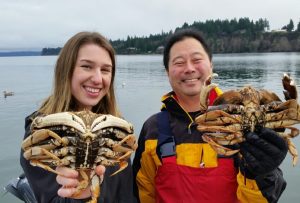
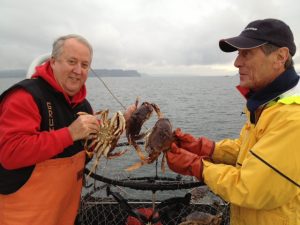
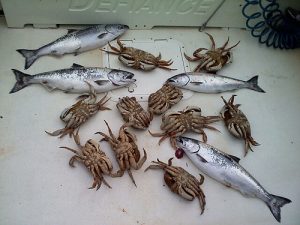
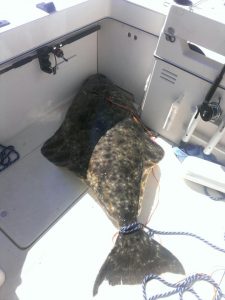
I have been reviewing these large harvest numbers which seem to be crushing the crab populations, if this pressure is not sustainable wouldn't it make sense to curtail the commercial pressure and buy out there licenses for a few years? If this would rebound the populations wouldn't that be good for moving forward in the future? It looks to me as though sport crabbers contribute far more to the economy of Washington than puget sound commercial industry? Is this wrong to conclude?
Disappointing to say the least for us south sound crabbers... Naturally, we are going to head north (i.e - area 10). Wonder what adverse impact this influx of pressure is going to have on that population; which already seems questionable? Or are there places in area 10 that can handle increased fishing?